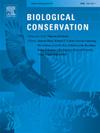在未来气候和土地利用变化的影响下,希腊保护区未能完全捕捉到不断变化的地方性热点:伯罗奔尼撒半岛就是一个例子
IF 4.4
1区 环境科学与生态学
Q1 BIODIVERSITY CONSERVATION
引用次数: 0
摘要
在人类世,保护规划必须适应导致全球生物多样性危机的快速环境变化。气候和土地利用变化的影响在地中海盆地等生物多样性热点地区尤为严重,那里独特的分类群和生态系统正日益面临风险。为了应对这些挑战,我们在希腊伯罗奔尼撒半岛(Peloponnese)进行了前瞻性的保护差距分析,为制定具有成本效益的保护策略提供了案例研究支持。伯罗奔尼撒半岛是地中海生物多样性热点的区域特有中心和关键组成部分。我们应用分类学和系统发育知情的方法来确定不同时期的地方性热点。在未来气候和土地利用情景下绘制了持续热点,并评估了它们与受保护和无道路地区的重叠程度。我们的分析显示,在未来几十年,地方性热点可能会在地理上发生变化,并在范围上缩小。虽然重点山区预计将保持其热点地位,但我们的研究结果表明,地方性和总体生物多样性丧失的普遍下降。令人担忧的是,最关键的持续热点与灭绝风险热点重叠。此外,高达46%的持续流行热点不在指定的保护区范围内,其中8%位于无路地区。我们的研究结果强调需要一个协调的多维战略,该战略应包括扩大现有的保护区网络,建立植物微保护区,以及地方性植物种群的迁移和强化。已确定的保护缺口代表了对环境变化具有持久恢复力的地区,使其成为长期保护规划的关键目标。本文章由计算机程序翻译,如有差异,请以英文原文为准。
Greek protected areas fail to fully capture shifting endemism hotspots under future climate and land-use change: The case of Peloponnese
In the Anthropocene, conservation planning must adapt to rapid environmental changes driving the global biodiversity crisis. The impacts of climate and land-use change are particularly severe in biodiversity hotspots like the Mediterranean Basin, where unique taxa and ecosystems are increasingly at risk. To address these challenges, we conducted a forward-looking conservation gap analysis in Peloponnese, Greece, a regional endemism centre and key component of the Mediterranean biodiversity hotspot, providing a case study to support the development of cost-effective conservation strategies. We applied a taxonomically and phylogenetically informed approach to identify endemism hotspots across different time-periods. Persistent hotspots were mapped under future climate and land-use scenarios, and their overlap with protected and roadless areas was assessed. Our analysis revealed that endemism hotspots will likely shift geographically and diminish in extent over the coming decades. While key mountainous regions are expected to retain their hotspot status, our results point to a widespread decline in endemism and overall biodiversity loss. Concerningly, the most critical persistent hotspots overlap with extinction risk hotspots. Moreover, up to 46 % of the persistent endemism hotspots are not covered by designated protected areas, and <8 % of those lie within roadless areas. Our results highlight the need for a coordinated multi-dimensional strategy that should include the expansion of the current network of protected areas, the establishment of plant micro-reserves, and the translocation and reinforcement of populations of endemics. The identified conservation gaps represent regions of enduring resilience to environmental change, making them critical targets for long-term conservation planning.
求助全文
通过发布文献求助,成功后即可免费获取论文全文。
去求助
来源期刊

Biological Conservation
环境科学-环境科学
CiteScore
10.20
自引率
3.40%
发文量
295
审稿时长
61 days
期刊介绍:
Biological Conservation is an international leading journal in the discipline of conservation biology. The journal publishes articles spanning a diverse range of fields that contribute to the biological, sociological, and economic dimensions of conservation and natural resource management. The primary aim of Biological Conservation is the publication of high-quality papers that advance the science and practice of conservation, or which demonstrate the application of conservation principles for natural resource management and policy. Therefore it will be of interest to a broad international readership.
 求助内容:
求助内容: 应助结果提醒方式:
应助结果提醒方式:


